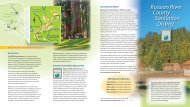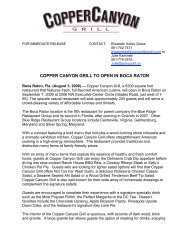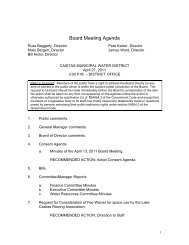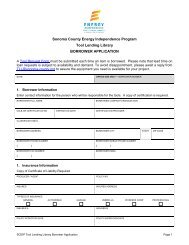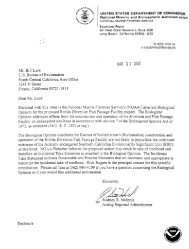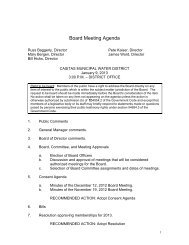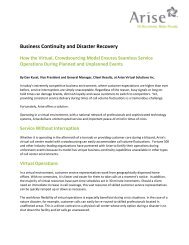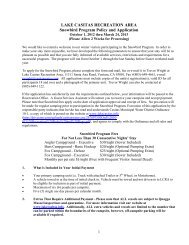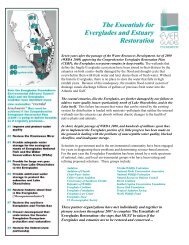Steering Committee Charter Template - DriveCMS
Steering Committee Charter Template - DriveCMS
Steering Committee Charter Template - DriveCMS
Create successful ePaper yourself
Turn your PDF publications into a flip-book with our unique Google optimized e-Paper software.
Disclaimer:<br />
The information contained within this document is offered only for general informational purposes. It does not<br />
constitute either general or specific legal advice and should not be substituted for legal, financial or other<br />
professional advice. This document was created for an energy independence program individualized for the<br />
County of Sonoma and may not be suitable for all public agencies. These materials are not promised or<br />
guaranteed to be current, complete, or up-to-date. Different factual situations and evolving case law may require<br />
substantial modifications to the enclosed documents. As such, the authors make no representations or<br />
warranties with respect to the accuracy or completeness of the contents of this document.
Sonoma County Energy Independence Program<br />
<strong>Steering</strong> <strong>Committee</strong> <strong>Charter</strong><br />
A<br />
Background<br />
On March 25, 2009, the Board of Supervisors established the Sonoma County Energy<br />
Independence Program (“SCEIP” or “Program”). SCEIP allows for commercial and<br />
residential property owners to finance energy and water efficiency improvements and<br />
renewable energy generation projects on their properties located within Sonoma<br />
County. The financing is made through a Property Assessed Clean Energy (PACE)<br />
financing model whereby a lien is placed on the property and the assessment is repaid<br />
through the property tax system.<br />
The initial pool of funds for financing was derived from $45 million of the County<br />
Treasury. Start-up costs of $1 million were financed by a loan from tobacco funds. The<br />
Sonoma County Water Agency (SCWA) recently invested an additional $15 million for<br />
financing. These funds will be replenished through the bonding process, which will<br />
allow the program to sustain and continue to provide financing for improvements.<br />
In addition to the financing, SCEIP provides assistance in determining improvement<br />
plans to property owners to identify the improvement that will provide the most<br />
significant results, identify alternative funding sources, rebates offered, and other<br />
services. The goal of the program is to provide the one-stop-shop resource to<br />
consumers on the programs and services required to achieve local energy<br />
independence through their efficiency and generation projects.<br />
B<br />
Purpose of the <strong>Steering</strong> <strong>Committee</strong><br />
Primary Functions<br />
The primary function of the <strong>Steering</strong> <strong>Committee</strong> is to take responsibility for the<br />
feasibility, business case and the achievement of outcomes of the Sonoma County<br />
Energy Independence Program (SCEIP). The SCEIP <strong>Steering</strong> <strong>Committee</strong> will monitor<br />
and review the program status, as well as provide oversight and suggestions on<br />
programmatic changes.<br />
Page 1 of 7
The <strong>Steering</strong> <strong>Committee</strong> provides a stabilizing influence so organizational concepts and<br />
directions are established and maintained with a visionary view. The <strong>Steering</strong><br />
<strong>Committee</strong> provides insight on long-term strategies in support of legislative mandates.<br />
Members of the <strong>Steering</strong> <strong>Committee</strong> ensure business objectives are being adequately<br />
addressed and the program remains under control. In practice, these responsibilities<br />
are carried out by performing the following functions:<br />
• Monitoring and review of the program at regular <strong>Steering</strong> <strong>Committee</strong> meetings;<br />
• Providing assistance to the program when required;<br />
• Controlling program scope as emergent issues force changes to be considered,<br />
ensuring that scope aligns with the agreed business requirements of program<br />
sponsor and key stakeholder groups;<br />
• Resolving program conflicts and disputes, reconciling differences of opinion and<br />
approach;<br />
• Formal acceptance of program deliverables.<br />
Approval Responsibilities<br />
The <strong>Steering</strong> <strong>Committee</strong> is responsible for approving program elements such as:<br />
• Approval of all requests for financing >$60k, via Program Administrator<br />
designation;<br />
• Signing all contracts >$60k, via Program Administrator designation;<br />
• Prioritization of program objectives and outcomes as identified in the program’s<br />
Strategic and Business Plans;<br />
• Deliverables as identified in the program Scope Statement;<br />
• Budget review, ensuring that effort, expenditures and changes are appropriate to<br />
stakeholder expectations;<br />
• Schedule;<br />
• Risk management strategies, ensuring that strategies to address potential threats<br />
to the program’s success have been identified, estimated and approved, and that<br />
the threats are regularly re-assessed;<br />
• Program management and quality assurance direction<br />
When a significant program change is recommended by the Program Administrator via<br />
the <strong>Steering</strong> <strong>Committee</strong>, the Program Administrator and County Counsel member will<br />
Page 2 of 7
meet with an Ad Hoc committee comprised of two representatives from the Sonoma<br />
County Board of Supervisors for discussion and approval of recommendation(s).<br />
C<br />
<strong>Steering</strong> <strong>Committee</strong><br />
Membership<br />
In addition to the program sponsor as ex-officio member, the <strong>Steering</strong> <strong>Committee</strong> will<br />
consist of the following stakeholder members:<br />
Subject Matter<br />
Expert Areas<br />
Program<br />
Administrator<br />
Organization<br />
ACTTC<br />
Resource<br />
David Sundstrom, ACTTC<br />
Legal County Counsel Kathy Larocque, Chief Deputy County<br />
Counsel<br />
Cory O’Donnell, Deputy County Counsel IV<br />
Finance and Real<br />
Estate<br />
Operations and<br />
Energy<br />
ACTTC<br />
General Services<br />
Jonathan Kadlec, Assistant Treasurer<br />
Dana Shern, Accountant/Auditor I/II<br />
Liz Yager, Program Manager<br />
Diane Lesko, Assistant Program Manager<br />
Gina Lehl, Assistant Program Manager<br />
Property Tax<br />
Collection<br />
Members at large<br />
ACTTC<br />
Pam Johnston, Assistant Tax-Collector<br />
Auditor<br />
Erick Roeser, Property Tax Manager<br />
John Haig, Redevelopment Manager<br />
Jose Obregon, Director of General Services<br />
Donna Dunk, Deputy Auditor Controller<br />
Treasurer Tax Collector<br />
Water Agency Representative - TBD<br />
Page 3 of 7
Stakeholder members will be identified by the program director.<br />
Role of a <strong>Steering</strong> <strong>Committee</strong> member<br />
It is intended that the <strong>Steering</strong> <strong>Committee</strong> leverage the experiences, expertise, and<br />
insight of key individuals in key organizations positioned to provide guidance and<br />
support for management and delivery of the program. <strong>Steering</strong> <strong>Committee</strong> members<br />
are not directly responsible for managing program activities, but provide support and<br />
guidance for those who do. Thus, individually, <strong>Steering</strong> <strong>Committee</strong> members should:<br />
• Understand the strategic implications and outcomes of initiatives being pursued<br />
through program outputs;<br />
• Appreciate the significance of the program for some or all major stakeholders<br />
and represent their interests;<br />
• Be genuinely interested in the initiative and be an advocate for broad support for<br />
the outcomes being pursued in the program;<br />
• Have a broad understanding of program management issues and approach<br />
being adopted.<br />
In practice, this means they:<br />
• Review the status of the program;<br />
• Ensure the program’s outputs meet the requirements of the business owners and<br />
key stakeholders;<br />
• Help balance conflicting priorities and resources;<br />
• Provide guidance to the program team and users of the program’s outputs;<br />
• Consider ideas and issues raised;<br />
• Check adherence of program activities to standards of best practice both within<br />
the organization and in a wider context;<br />
• Foster positive communication outside of the Team regarding the program’s<br />
progress and outcomes;<br />
• Report on program progress to those responsible at a high level, such as agency<br />
executive management groups, heads of agencies, or Governor’s Cabinet; and<br />
Page 4 of 7
• Process any whole-of-Government issues associated with the program.<br />
Page 5 of 7
Key Assumptions and Constraints<br />
The SCEIP <strong>Steering</strong> <strong>Committee</strong> will:<br />
• Maintain a financially viable program;<br />
• Sustain the program in support of the countywide climate action and economic<br />
development goals as aligned with the Sonoma County Strategic Plan;<br />
• Act as key champions of the program; and<br />
• Prevail in the face of the FHFA determinations of July 7, 2010.<br />
D<br />
<strong>Steering</strong> <strong>Committee</strong> Meetings<br />
Meeting Schedule and Process<br />
The Team will meet regularly as required to keep track of issues and the progress of the<br />
program’s implementation and on-going statewide support to its stakeholders. At least<br />
one subject matter expert from the represented areas: Program, Finance, and County<br />
Counsel shall attend each meeting. The members at large shall attend as topics of<br />
interest are placed on the agenda or as time permits.<br />
The Program Sponsor chairs the <strong>Steering</strong> <strong>Committee</strong> and facilitates the <strong>Steering</strong><br />
<strong>Committee</strong> Meeting. The Team will follow modified Roberts Rules of Order in the<br />
conduct of meetings, motions, discussion and voting.<br />
Meeting Agenda<br />
At each meeting, program status will be reported to the Team by the program manager<br />
using an agenda outline such as the following:<br />
A. Introductory Items<br />
• Review Files<br />
• Contract Signings<br />
• New Business Items<br />
B. Review Program Status<br />
• Budget/Finance<br />
• Old Business Updates<br />
Page 6 of 7
C. Consideration of other items relevant to the program<br />
D. Policy Items<br />
• Ad Hoc Items<br />
E. Next Board Date<br />
Program meeting agendas and minutes shall be the responsibility of the Program<br />
Members. Historical meeting records are located on the General Services SharePoint<br />
site at SCEIP Docs > Shared Documents > <strong>Steering</strong> <strong>Committee</strong> Meeting Notes.<br />
E<br />
Program Timeline<br />
Program Start Date March 2009<br />
Anticipated date of achieving sustained<br />
and routine operations<br />
Anticipated completion date<br />
March 2013<br />
When all Sonoma County Structures are at<br />
net zero<br />
\\sv-gensvcs\GENSVCS-DATA\ENERGY SUSTAINABILITY\Project AB811 SCEIP\Replication\15 Local Process\SCEIP <strong>Steering</strong> <strong>Committee</strong><br />
<strong>Charter</strong>.doc<br />
Page 7 of 7



